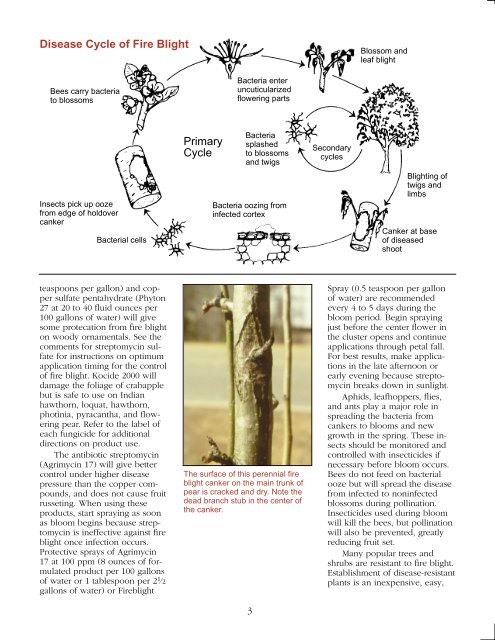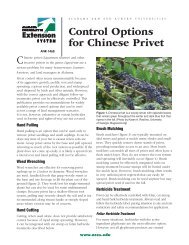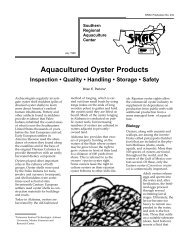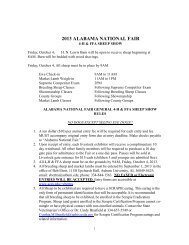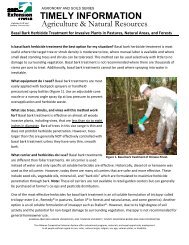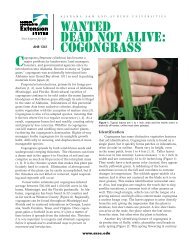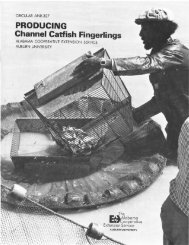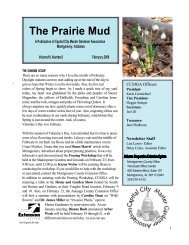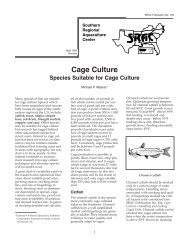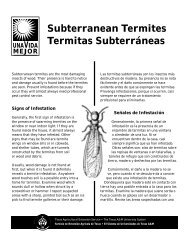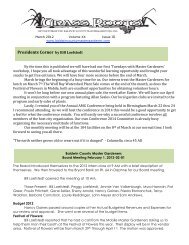Fire Blight on Fruit Trees and Woody Ornamentals - Alabama ...
Fire Blight on Fruit Trees and Woody Ornamentals - Alabama ...
Fire Blight on Fruit Trees and Woody Ornamentals - Alabama ...
Create successful ePaper yourself
Turn your PDF publications into a flip-book with our unique Google optimized e-Paper software.
Disease Cycle of <str<strong>on</strong>g>Fire</str<strong>on</strong>g> <str<strong>on</strong>g>Blight</str<strong>on</strong>g><br />
Bees carry bacteria<br />
to blossoms<br />
Insects pick up ooze<br />
from edge of holdover<br />
canker<br />
Bacterial cells<br />
teaspo<strong>on</strong>s per gall<strong>on</strong>) <strong>and</strong> copper<br />
sulfate pentahydrate (Phyt<strong>on</strong><br />
27 at 20 to 40 fluid ounces per<br />
100 gall<strong>on</strong>s of water) will give<br />
some protecati<strong>on</strong> from fire blight<br />
<strong>on</strong> woody ornamentals. See the<br />
comments for streptomycin sulfate<br />
for instructi<strong>on</strong>s <strong>on</strong> optimum<br />
applicati<strong>on</strong> timing for the c<strong>on</strong>trol<br />
of fire blight. Kocide 2000 will<br />
damage the foliage of crabapple<br />
but is safe to use <strong>on</strong> Indian<br />
hawthorn, loquat, hawthorn,<br />
photinia, pyracantha, <strong>and</strong> flowering<br />
pear. Refer to the label of<br />
each fungicide for additi<strong>on</strong>al<br />
directi<strong>on</strong>s <strong>on</strong> product use.<br />
The antibiotic streptomycin<br />
(Agrimycin 17) will give better<br />
c<strong>on</strong>trol under higher disease<br />
pressure than the copper compounds,<br />
<strong>and</strong> does not cause fruit<br />
russeting. When using these<br />
products, start spraying as so<strong>on</strong><br />
as bloom begins because streptomycin<br />
is ineffective against fire<br />
blight <strong>on</strong>ce infecti<strong>on</strong> occurs.<br />
Protective sprays of Agrimycin<br />
17 at 100 ppm (8 ounces of formulated<br />
product per 100 gall<strong>on</strong>s<br />
of water or 1 tablespo<strong>on</strong> per 2 1 ⁄2<br />
gall<strong>on</strong>s of water) or <str<strong>on</strong>g>Fire</str<strong>on</strong>g>blight<br />
Primary<br />
Cycle<br />
Bacteria enter<br />
uncuticularized<br />
flowering parts<br />
Bacteria<br />
splashed<br />
to blossoms<br />
<strong>and</strong> twigs<br />
Bacteria oozing from<br />
infected cortex<br />
The surface of this perennial fire<br />
blight canker <strong>on</strong> the main trunk of<br />
pear is cracked <strong>and</strong> dry. Note the<br />
dead branch stub in the center of<br />
the canker.<br />
3<br />
Sec<strong>on</strong>dary<br />
cycles<br />
Blossom <strong>and</strong><br />
leaf blight<br />
<str<strong>on</strong>g>Blight</str<strong>on</strong>g>ing of<br />
twigs <strong>and</strong><br />
limbs<br />
Canker at base<br />
of diseased<br />
shoot<br />
Spray (0.5 teaspo<strong>on</strong> per gall<strong>on</strong><br />
of water) are recommended<br />
every 4 to 5 days during the<br />
bloom period. Begin spraying<br />
just before the center flower in<br />
the cluster opens <strong>and</strong> c<strong>on</strong>tinue<br />
applicati<strong>on</strong>s through petal fall.<br />
For best results, make applicati<strong>on</strong>s<br />
in the late afterno<strong>on</strong> or<br />
early evening because streptomycin<br />
breaks down in sunlight.<br />
Aphids, leafhoppers, flies,<br />
<strong>and</strong> ants play a major role in<br />
spreading the bacteria from<br />
cankers to blooms <strong>and</strong> new<br />
growth in the spring. These insects<br />
should be m<strong>on</strong>itored <strong>and</strong><br />
c<strong>on</strong>trolled with insecticides if<br />
necessary before bloom occurs.<br />
Bees do not feed <strong>on</strong> bacterial<br />
ooze but will spread the disease<br />
from infected to n<strong>on</strong>infected<br />
blossoms during pollinati<strong>on</strong>.<br />
Insecticides used during bloom<br />
will kill the bees, but pollinati<strong>on</strong><br />
will also be prevented, greatly<br />
reducing fruit set.<br />
Many popular trees <strong>and</strong><br />
shrubs are resistant to fire blight.<br />
Establishment of disease-resistant<br />
plants is an inexpensive, easy,


